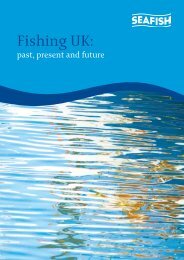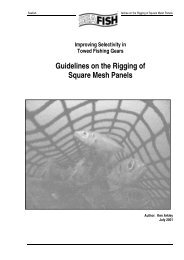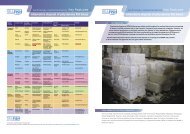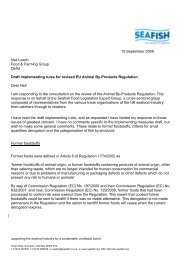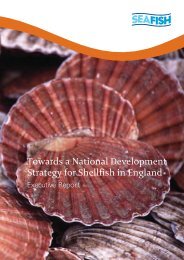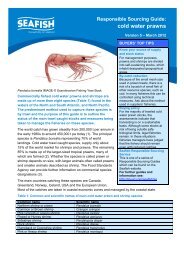You also want an ePaper? Increase the reach of your titles
YUMPU automatically turns print PDFs into web optimized ePapers that Google loves.
Research & Development<br />
Species guide<br />
March 2011 2 nd edition<br />
<strong>Gurnards</strong><br />
<strong>Gurnards</strong> belong to the Triglidae family (1) of<br />
fish. There are three common species: red,<br />
yellow/tub and grey gurnard. They vary by<br />
colour but are very similar in shape and taste.<br />
Red gurnard<br />
Distribution<br />
Red gurnard is widely distributed in the<br />
North East Atlantic from southern Norway<br />
and north to Mauritania.<br />
Red gurnard, Aspitrigla cuculus, is the<br />
smallest of the European gurnards. It spawns<br />
in summer, can attain a length of 40 cms, a<br />
weight of 900g and lives to a maximum of 21.<br />
Tub gurnard<br />
Tub gurnard occurs in the Eastern Atlantic<br />
from Norway to Senegal, also in South Africa<br />
and in the Mediterranean Sea.<br />
Tub gurnard, Chelidonicthys lucerna, is the<br />
largest European. It spawns from May to July,<br />
can attain a length of 75 cms and lives to a<br />
maximum of 15 years.<br />
Grey gurnard<br />
Grey gurnard occurs in the Eastern Atlantic<br />
from Iceland, in Norway, the southern Baltic<br />
and the North Sea to southern Morocco.<br />
Grey gurnard, Eutrigla gurnardus, spawns<br />
from April to August, can attain a length of 45<br />
cms and lives to a maximum of six years.
2 Species Guide – <strong>Gurnards</strong>. March 2011 v2.<br />
Biology<br />
<strong>Gurnards</strong> are able to grunt or growl by using<br />
muscles associated with the swim bladder<br />
and this is believed to aid in keeping schools<br />
together. They feed on benthic crustaceans,<br />
other invertebrates and bottom-dwelling<br />
fishes.<br />
Fisheries and gears<br />
Red gurnard is mainly caught in a mixed<br />
fishery by otter trawlers. Tub and grey<br />
gurnard are mainly taken as a bycatch in<br />
mixed demersal fisheries for flatfish and<br />
roundfish.<br />
However the market for gurnard is limited and<br />
they are often thrown back into the sea as an<br />
unwanted bycatch and subsequently<br />
discarded. Surveys indicate that this species<br />
is one of the most widely discarded (3).<br />
Stock assessment and catches<br />
There are no formal assessments or advice<br />
on gurnards However, there are a number of<br />
sources of information on these species and<br />
their role in the ecosystem (4,5,6).<br />
According to landings statistics the annual<br />
catches in the North East Atlantic from 2006-<br />
2009 have been (2):<br />
Tonnes 2006 2007 2008 2009<br />
Red 5171 5175 4778 4055<br />
Tub 2995 3416 2510 3058<br />
Grey 529 399 317 438<br />
There are uncertainties in landings data and<br />
some nations do not discriminate between<br />
the species in the landings data.<br />
Red gurnard – French fishing vessels land<br />
the most red gurnard and it is data from these<br />
and research vessels which provide the best<br />
time series for this species. Information is<br />
available for the Bay of Biscay, Celtic Sea,<br />
Western Approaches, English Channel and<br />
North Sea. Most of these time series indicate<br />
fluctuations in abundance without trends, with<br />
the exception of the North Sea where there<br />
appears to have been an upward trend in the<br />
last decade.<br />
Tub gurnard – As for red gurnard, French<br />
trawl fisheries and research vessel data<br />
provide the best time series for this species.<br />
Information is available for the Bay of Biscay,<br />
Celtic Sea, Western Approaches, English<br />
Channel and North Sea. Most of these results<br />
indicate fluctuation in abundance without<br />
trend with some evidence of increasing<br />
numbers of tub gurnard overwintering in the<br />
North Sea in recent years. This effect has<br />
been observed with other species such as<br />
red mullet which until recently did not<br />
overwinter in the North Sea.<br />
Grey gurnard – Due to their low commercial<br />
value there is widespread discarding of this<br />
species so only research vessel data can be<br />
considered a valid source of information. The<br />
research vessel surveys in the North Sea<br />
show a marked increase in abundance over<br />
the period 1987-2009, and relatively stable,<br />
though fluctuating abundance in the<br />
Skagerrak and Kattegat.<br />
Ecological aspects<br />
<strong>Gurnards</strong> are key predators in the North Sea<br />
and their importance is considered to have<br />
increased over recent years (4).<br />
Sustainability<br />
Taken together the information described<br />
above suggests that gurnard populations are<br />
relatively robust; that is current exploitation is<br />
not likely to seriously affect their abundance.<br />
Responsible Sourcing Services<br />
This guide is one of a series of <strong>Seafish</strong><br />
Responsible Sourcing Guides.<br />
See:<br />
http://www.tinyurl.com/seafishrsg
3 Species Guide – <strong>Gurnards</strong>. March 2011 v2.<br />
Product Characteristics<br />
<strong>Gurnards</strong> are very distinctive bottom-living<br />
fish with large heads and eyes. The head is<br />
protected by large bony plates and strong<br />
spines. The lower three rays of the pectoral<br />
fins are separate, finger-like processes that<br />
contain sensory organs.<br />
Red gurnards are bright red with pinkishsilver<br />
mottling on the sides and head. The<br />
protective bony plates on the head which are<br />
characteristic of all gurnards are very<br />
conspicuous in this species. Along the lateral<br />
line there is a row of large, plate-like scales.<br />
Tub gurnards can vary in colour from bright<br />
red with pinkish mottling to yellowish-brown<br />
with darker brown or green mottling. The<br />
pectoral fins have brilliant peacock blue spots<br />
and outer rim.<br />
The grey gurnard is a relatively slender<br />
bodied gurnard with a sharply pointed snout.<br />
The colour ranges from grey to greyish-brown<br />
with small whitish-cream spots and there is a<br />
characteristic dark blotch on the rear edge of<br />
the first dorsal fin.<br />
<strong>Gurnards</strong> are most commonly used in fish<br />
stocks, soups or Mediterranean fish stews. It<br />
may be marketed fresh or frozen and eaten<br />
pan-fried, broiled, micro-waved or baked.<br />
The Gurnard is a tricky fish to fillet and<br />
‘debone’, but has been gaining in popularity.<br />
The red gurnard was the winner of the<br />
Billingsgate School Sustainable Seafood<br />
Award 2008 (7) and has been increasingly<br />
endorsed by celebrity chefs. There is a recipe<br />
for red gurnard in Rick Stein’s Mediterranean<br />
Escapes (BBC Books, 2007). The River<br />
Cottage Fish Book by Hugh Fearnley-<br />
Whittingstall and Nick Fisher (Bloomsbury,<br />
2007) includes red gurnard recipes for ‘Potroasted<br />
gurnard’, as a whole white fish in<br />
‘Crustacean soup’ and a descaled and gutted<br />
red gurnard for cooking as ‘Deep-fried whole<br />
fish with citrus salsa’.<br />
Supply chain standards<br />
<strong>Seafish</strong> has developed supply chain<br />
standards from capture to retailer:<br />
• Responsible Fishing Scheme.<br />
Sets best practice standards for<br />
fishing vessels: (BSi: PAS 72:2006).<br />
• British Retail Consortium (BRC)<br />
Global Standard/Safe and Local<br />
Supplier Approval (SALSA)<br />
certification. Designed to raise<br />
standards in the seafood processing<br />
and wholesaling sectors.<br />
References and sources<br />
1.www.food.gov.uk/foodindustry/guidancenotes/la<br />
belregsguidance/fishlabellingregs2010eng<br />
2. www.ices.dk/fish/CATChSTATISTICS.asp<br />
3. Enever R et al 2007 Fisheries Research 86<br />
(2007) 143–152.<br />
4. Mackinson S and G. Daskalov (2007) Sci.<br />
Ser. Tech Rep., Cefas Lowestoft, 142: 196pp.<br />
5.www.ices.dk/reports/ACOM/2007/WGNEW/WG<br />
NEW07.pdf<br />
6.www.ices.dk/reports/ACOM/2010/WGNEW/WG<br />
NEW%202010%20.pdf<br />
7.www.seafoodtraining.org/6_mike_berhtet_m&j_<br />
seafood_27.02.08.pdf<br />
Contact:<br />
Bill Lart - Tel: 01472 252323<br />
Email: w_lart@seafish.co.uk<br />
Karen Green - Email: k_green@seafish.co.uk<br />
18 Logie Mill, Logie Green Road, Edinburgh EH7 4HS<br />
t: 0131 558 3331 f: 0131 558 1442<br />
e: seafish@seafish.co.uk w: www.seafish.org SIN: http://sin.seafish.org<br />
supporting the seafood industry for a sustainable, profitable future






